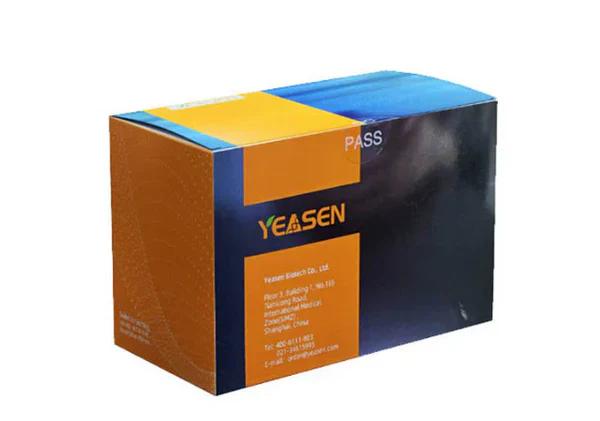Description
Phalloidin is a cyclic heptapeptide toxin derived from the death cap mushroom (Amanita phalloides). It binds to filamentous actin (F-actin) with high affinity (Kd = 20 nM) and does not bind to globular actin (G-actin). It is commonly used to label F-actin in tissue sections, cell cultures, or cell-free systems for qualitative and quantitative analysis. Phalloidin derivatives also bind to actin filaments from both animal and plant sources, including muscle and non-muscle cells, at a stoichiometric ratio of approximately one phalloidin molecule per actin subunit. Non-specific binding is negligible, providing clear distinction between stained and unstained regions. Therefore, phalloidin derivatives are particularly suitable as a substitute for actin antibodies in related research. Additionally, phalloidin derivatives are small, with a diameter of approximately 12-15 Å and a molecular weight of less than 2000 Daltons. Many physiological properties of actin are maintained, such as the ability to interact with actin-binding proteins like myosin, tropomyosin, and DNase I. Phalloidin-labeled filaments can still penetrate solid myosin matrices, and glycerol-extracted muscle fibers can contract after labeling.
Phalloidin binding inhibits the depolymerization of filamentous actin (microfilaments), stabilizing their structure and disrupting the dynamic equilibrium of polymerization and depolymerization. This property reduces the critical concentration (CC) for actin polymerization to less than 1 µg/mL, making it a potent polymerization promoter. Additionally, phalloidin inhibits the ATP hydrolysis activity of F-actin.
This product is TRITC (tetramethylrhodamine isothiocyanate)-labeled phalloidin, which offers high specificity and contrast in staining, superior to actin antibodies. It is suitable for qualitative and quantitative detection of F-actin. The F-actin bound by this product maintains many biological properties of actin itself. Moreover, this product has no species differences and is widely applicable.
We provide TRITC-labeled phalloidin in two forms: lyophilized powder (Cat No.: 40734ES80) and storage solution (Cat No.: 40734ES75, 20 µM concentration). Users can choose according to their needs. The recommended working concentration is 80-200 nM.
Features
Binds selectively to filamentous actin (F-actin).
Phalloidin is not species-specific and exhibits virtually no non-specific staining, providing extremely clear contrast between stained and unstained regions.
It is highly compatible and does not affect the activity of actin.
Applications
The tight and selective binding to F-actin reveals the distribution of microfilament cytoskeleton within the cell.
Specifications
|
Formula |
C60H70N12O13S2 |
|
Molecular Weight |
1231.4 |
|
Excitation/Emission |
540~546/565~575 nm |
|
Sequence |
TRITC-bicyclic(Ala-DThr-Cys-cis-4-hydroxy-Pro-Ala-2-mercapto-Trp-4-hydroxy-5-amino-L eu)(S-3 to 6) |
|
Appearance |
Purple powder (lyophilized powder) |
|
Solubility |
Soluble in DMSO, DMF, methanol, or acetonitrile water solution (20%) |
Components
|
Components No. |
Name |
40734ES75 |
40734ES80 |
|
40734 |
Phalloidin-TRITC Conjugate |
300 T |
1 mg |
Shipping and Storage
The product is shipped with ice pack. Can be stored at -15°C ~-25°C in a dark, dry environment for up to one year.
Documents:
Safety Data Sheet
Manuals
Citations & References:
[1] Wang D, Yin Y, Wang S, et al. FGF1ΔHBS prevents diabetic cardiomyopathy by maintaining mitochondrial homeostasis and reducing oxidative stress via AMPK/Nur77 suppression. Signal Transduct Target Ther. 2021;6(1):133. Published 2021 Mar 24. doi:10.1038/s41392-021-00542-2(IF:18.187)
[2] Li J, Niu J, Min W, et al. B7-1 mediates podocyte injury and glomerulosclerosis through communication with Hsp90ab1-LRP5-β-catenin pathway [published online ahead of print, 2022 Jun 16]. Cell Death Differ. 2022;10.1038/s41418-022-01026-8IF: 13.7 Q1 . doi:10.1038/s41418-022-01026-8(IF:15.828)
[3] Fu J, Zhu W, Liu X, et al. Self-activating anti-infection implant. Nat Commun. 2021;12(1):6907. Published 2021 Nov 25. doi:10.1038/s41467-021-27217-4(IF:14.919)
[4] Xie M, Shi Y, Zhang C, et al. In situ 3D bioprinting with bioconcrete bioink. Nat Commun. 2022;13(1):3597. Published 2022 Jun 23. doi:10.1038/s41467-022-30997-y(IF:14.919)
[5] Chen Q, Yu S, Zhang D, et al. Impact of Antifouling PEG Layer on the Performance of Functional Peptides in Regulating Cell Behaviors. J Am Chem Soc. 2019;141(42):16772-16780. doi:10.1021/jacs.9b07105(IF:14.695)
[6] Lin X, Wang Q, Gu C, et al. Smart Nanosacrificial Layer on the Bone Surface Prevents Osteoporosis through Acid-Base Neutralization Regulated Biocascade Effects. J Am Chem Soc. 2020;142(41):17543-17556. doi:10.1021/jacs.0c07309(IF:14.612)
[7] Sun KY, Wu Y, Xu J, et al. Niobium carbide (MXene) reduces UHMWPE particle-induced osteolysis. Bioact Mater. 2021;8:435-448. Published 2021 Jul 1. doi:10.1016/j.bioactmat.2021.06.016(IF:14.593)
[8] Jin D, Yang S, Wu S, Yin M, Kuang H. A functional PVA aerogel-based membrane obtaining sutureability through modified electrospinning technology and achieving promising anti-adhesion effect after cardiac surgery. Bioact Mater. 2021;10:355-366. Published 2021 Aug 19. doi:10.1016/j.bioactmat.2021.08.013(IF:14.593)
[9] He Y, Gallman AE, Xie C, et al. P2RY8 variants in lupus patients uncover a role for the receptor in immunological tolerance. J Exp Med. 2022;219(1):e20211004. doi:10.1084/jem.20211004(IF:14.307)
[10] Qin X, Guo H, Wang X, et al. Exosomal miR-196a derived from cancer-associated fibroblasts confers cisplatin resistance in head and neck cancer through targeting CDKN1B and ING5. Genome Biol. 2019;20(1):12. Published 2019 Jan 14. doi:10.1186/s13059-018-1604-0(IF:14.028)
Payment & Security
Your payment information is processed securely. We do not store credit card details nor have access to your credit card information.
Inquiry
You may also like
FAQ
The product is for research purposes only and is not intended for therapeutic or diagnostic use in humans or animals. Products and content are protected by patents, trademarks, and copyrights owned by Yeasen Biotechnology. Trademark symbols indicate the country of origin, not necessarily registration in all regions.
Certain applications may require additional third-party intellectual property rights.
Yeasen is dedicated to ethical science, believing our research should address critical questions while ensuring safety and ethical standards.

